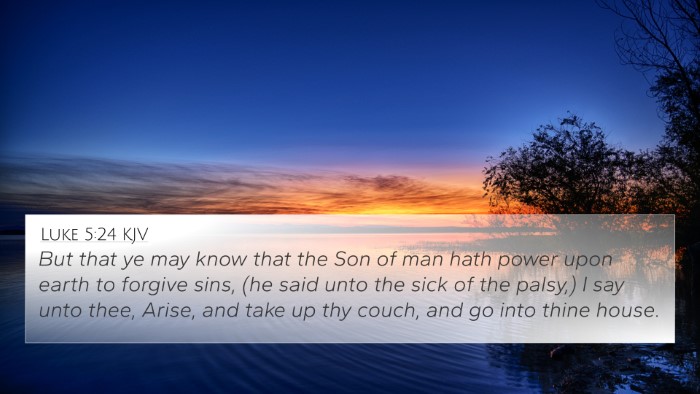Understanding John 5:8
John 5:8 states: "Jesus said to him, 'Get up, take up your bed, and walk.'" This powerful command not only demonstrates Jesus's authority but also unveils significant theological implications related to healing, obedience, and faith.
Verse Meaning and Context
The context of this verse takes place at the Pool of Bethesda, where a man who had been ill for 38 years was waiting for the moving of the waters to receive healing. Jesus approaches him and asks if he wants to be made well. The man's response shows his frustration and helplessness, highlighting the nature of his condition.
Matthew Henry notes that Jesus’s words, "Get up," represent a command that requires action. His healing was not just an act of divine mercy but also an invitation to respond in faith. Albert Barnes amplifies this idea, stating that the act of rising up demonstrated the man's faith in Jesus's power. Adam Clarke elaborates by mentioning that the command to take up his bed implies a restoration of the man's physical strength and dignity.
Significance of Jesus' Command
Divine Authority: Jesus’s command illustrates His authority over physical ailments. The immediate healing and ability to walk again signify that God's power supersedes all human limitations.
Obedience and Faith: The man's willingness to obey Jesus's command, despite his long-standing condition, exemplifies an act of faith. His actions prompted by Jesus's words show a significant transformation from despair to hope.
Related Bible Cross-References
- Matthew 9:6 - "But that you may know that the Son of Man has power on earth to forgive sins..." illustrates the authority of Jesus to heal and forgive.
- Mark 2:11 - "I say to you, arise, take up your bed, and go to your house," further reflects Jesus’s ability to heal and the immediate response needed from the recipient.
- Luke 5:24 - Similar to the accounts in Matthew and Mark, emphasizing the theme of faith and healing.
- James 5:15 - "And the prayer of faith will save the sick," connects the act of faith with divine healing.
- Isaiah 53:5 - "By His stripes we are healed," speaks to the broader spiritual implications of healing through Christ.
- Acts 3:6-8 - The healing of the lame man by Peter, echoing the authority given to the apostles to perform miracles in Jesus’s name.
- John 14:13-14 - "And whatever you ask in My name, that I will do," shows the continued work of Christ through believers.
- Romans 1:16 - "For I am not ashamed of the gospel of Christ, for it is the power of God to salvation," underscores the transformative power inherent in faith.
- John 9:7 - The healing of a blind man, which also illustrates Jesus’s penchant for restoring life and capability.
- 1 Peter 2:24 - "By whose stripes you were healed," bridges the understanding of physical and spiritual healing through Jesus's sacrifice.
Thematic Bible Verse Connections
This verse connects to broader themes in Scripture, particularly regarding healing, faith, and action. The connections between Bible verses shine a light on how Jesus's miracles are not isolated events but part of a larger narrative of restoration and redemption.
Bible concordance tools can assist in studying these relationships, helping believers understand the linkages and significance of Jesus's commands within the biblical narrative.
Application and Reflection
In reflecting on John 5:8, believers are encouraged to consider their own areas of stagnation or hopelessness. Just as the man at the Pool of Bethesda responded to Jesus’s command, individuals today are called to respond to God with faith and obedience.
Further, cross-referencing Bible study methods can be utilized to draw deeper insights into one's walk with God, emphasizing that healing—whether physical, emotional, or spiritual—requires both divine intervention and human action.
Conclusion
John 5:8 encapsulates the essence of Jesus’s ministry, illustrating profound truths about His identity and the nature of faith. The act of rising and walking serves as a prophetic call for all believers to act upon the words of Christ in their own lives.






